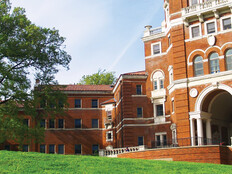EDUCAUSE 2019: Diverse Campus Initiatives Depend on Advanced Wi-Fi Solutions
Access points shine when they hum quietly behind the scenes, delivering connectivity so seamless that users enjoy it without a second thought. In fact, high-performing Wi-Fi is the workhorse of many campus initiatives, and APs are critical to making it work.
That was the theme of “Increasing Student Success with High-Density Wi-Fi,” a presentation delivered Wednesday at the annual EDUCAUSE Conference in Chicago.
Joyce Kim, an educational technology analyst with research and consulting firm Ovum, moderated the conversation with Barry Arnold, director of network and data center operations at Georgetown University; Marc Benner, assistant CIO at Illinois College; and Peter Williams, associate vice president of IT and CIO at Butler University.
JOIN THE CONVERSATION: Follow @EdTech_HigherEd on Twitter for continued EDUCAUSE coverage.
Reliable APs Facilitate Both Connectivity and Resulting Data
When Butler sought to upgrade a 10-year-old network, the university went with a Cisco Meraki solution, ultimately deploying 1,300 APs across campus. The goal was, in part, to meet the baseline of connectivity that students expect, especially during periods of high demand, Williams said.
“The density of the environment we experience is pretty significant,” Williams said, pointing to students’ tendency to be early adopters of any new technological device.
Better visibility into network traffic through the Meraki dashboard has made a dramatic difference in the IT team’s ability to manage the network, he said: “It’s opened a whole new way of how we might approach serving our customer.”
Improved Wi-Fi is also helping Butler pursue a program of data-driven insights and interventions for student success. For instance, data about campus traffic patterns helps administrators understand how students are using facilities. Bluetooth beacons and application programming interface integrations make it possible for students to receive timely notifications in an app, based on their personal preferences, when they go to certain locations on campus.
The ability to aggregate data about students’ locations also has public safety applications, Williams said. In the past, reports of missing persons (even if they were false alarms raised by concerned parents) could send police on a “needle in the haystack” search, he said.
Now, staff can look at a student’s path on the network to determine where his or her devices might be, or track location via card access in a building. The next iteration of leveraging that data might be to derive behavioral insights that can be used to help students in other ways too.
“How might we leverage those to support student success, in a sensitive way?” Williams said, acknowledging the need to address privacy concerns.
At Illinois College, a small IT team made an easy-to-manage AP solution a must. It also chose Cisco Meraki as a centralized, cloud-managed platform that included APs, switches, endpoint management, and security appliances and cameras.
Installing new APs in residence halls was one major improvement. In the past, APs were placed in hallways, Benner said, but the bandwidth demand got so high that students had to keep their doors open just to get a signal.
Today, the network supports connectivity whether students are online to do coursework, practice for the esports team or enjoy online entertainment. At Georgetown, a recent deployment of 2,500 APs in 17 buildings — more than double the previous number — has created the Wi-Fi-only environment that students expect.
In truth, Arnold said, “they aren’t really jumping up and down saying the Wi-Fi is so much better this year. They just expect it to work.”
For IT staff, however, making that happen had its challenges, including the logistics of upgrading technology in aging buildings (Georgetown was founded in 1789) and coordinating with faculty to ensure upgrades didn’t disrupt classrooms.
MORE FROM EDTECH: See how Wi-Fi is supporting supports smart campus initiatives.
Meraki Dashboard Helps IT Staff Address Rogue Devices
Advanced network solutions also make it easier for IT staff to do their jobs, panelists said. In particular, they cited greater ease in identifying and managing rogue devices.
“There’s a much greater visibility into the things — not even on your network — but around your network,” Williams said.
For example, staff can see that something on the network is behaving like a router, alerting them that a student may be attempting to stand up a prohibited device.
“That has been the exciting part of the Meraki dashboard, being able to identify those rogue devices and take action quickly,” Benner said.
As one audience member said, rogue devices have become “a major issue,” particularly when they create performance issues that users don’t understand and, as a result, trigger complaints about the IT service to senior staff or social media.
It’s a problem that’s likely to increase as users attempt to build their own connected devices, Arnold said.
“That’s one area we’re trying to resolve, the Internet of Things,” he said — and how to support all the networked devices here now, and on the way.
See more of our EDUCAUSE coverage here.









